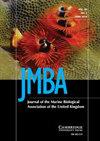Diet composition, diel feeding periodicity and daily ration of mature adult Diaphus fulgens (Teleostei: Myctophidae) in the Kuroshio waters
IF 0.9
4区 生物学
Q3 MARINE & FRESHWATER BIOLOGY
Journal of the Marine Biological Association of the United Kingdom
Pub Date : 2023-07-10
DOI:10.1017/S002531542300036X
引用次数: 0
Abstract
Abstract Diaphus fulgens is a diel vertical migrant myctophid, occurring abundantly in the Kuroshio waters of the East China Sea. They are multiple batch spawners with a short interspawn period, resulting in high egg productivity. Multiple spawning would be supported by feeding during their spawning season; however, there is no information on the feeding habits of this species. The present study examined the diet composition, diel feeding periodicity and daily ration of mature adult D. fulgens collected at different periods of the day during February to March. The most prevalent item was appendicularians and their mucus houses, which dominated the stomach contents in both number and weight. Additionally, various species of copepods were predated, with a prevalence, by weight, of the large-sized Pleuromamma piseki. Diaphus fulgens feeds actively in the epipelagic layer at night and moves down to the mesopelagic layer in the early morning, and digests most of the consumed food by the late afternoon, showing a typical nocturnal feeding pattern. Based on diel changes in the stomach content index and instantaneous gastric evacuation rate estimated in this study (0.118–0.129 h−1), the daily ration was calculated to be 4.0–4.2% of body weight, equivalent to a daily caloric intake of 21.2–22.3 cal day−1. Since the caloric value to produce a batch of oocytes was estimated to be 8.2–11.5 cal day−1, on an energetic basis, D. fulgens can maintain the multiple spawning at a cost of approximately 37–54% of its daily caloric intake.黑潮水域黄颡鱼(Teleostei: mytophidae)成虫的日饲料组成、摄食周期和日定量
摘要:黄颡鱼是东海黑潮水域中大量存在的一种垂直洄游嗜鱼。它们是多批产卵者,产卵间隔时间短,产卵率高。在产卵季节通过进食来支持多次产卵;然而,没有关于这个物种的食性的信息。研究了2 ~ 3月不同时段采集的黄颡鱼成虫的日粮组成、日采食周期和日定量。最常见的是阑尾虫和它们的粘液屋,它们在数量和重量上都占主导地位。此外,许多种类的桡足类动物在此之前就已经存在,以重量计,大型胸鳍鱼(Pleuromamma piseki)普遍存在。黄横鱼夜间在上层捕食活跃,清晨下移至中层,傍晚消化掉大部分进食的食物,呈现典型的夜间捕食模式。根据胃内容物指数的变化和本研究估计的瞬时胃排空率(0.118-0.129 h - 1),计算出日摄食量为体重的4.0-4.2%,相当于每日摄入21.2-22.3 cal day - 1。由于产生一批卵母细胞的热量值估计为8.2-11.5 cal day−1,因此在能量基础上,富尔根D.可以维持多次产卵,其成本约为其每日热量摄入的37-54%。
本文章由计算机程序翻译,如有差异,请以英文原文为准。
求助全文
约1分钟内获得全文
求助全文
来源期刊
CiteScore
2.30
自引率
8.30%
发文量
68
审稿时长
3-8 weeks
期刊介绍:
JMBA is an international journal, publishing original research on all aspects of marine biology. It includes pioneering work taking place today on major issues concerning marine organisms and their environment. Subjects covered include: ecological surveys and population studies of marine communities; physiology and experimental biology; taxonomy, morphology and life history of marine animals and plants; and chemical and physical oceanographic work. Included with 2010 online subscriptions: Marine Biodiversity Records.

 求助内容:
求助内容: 应助结果提醒方式:
应助结果提醒方式:


